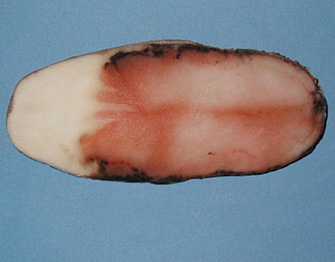Please click here to access the main AHDB website and other sectors.
- Home
- Knowledge library
- Pink rot
Pink rot

Pink rot (Phytophthora erythroseptica) can be devastating especially in hot dry years however wet soil is required for infection.
Symptoms
Rotting tubers can sometimes be spotted at lifting where soil sticks firmly to the affected surface. The skin might also be loose and have blackened lenticels. Affected tubers usually rot from the heel end. Externally the infection front has a dark edge but this is not the case on the internal cut surface. There is often a distinctive sweet smell and the relatively firm infected flesh oozes a clear colourless liquid if squeezed hard. Initially the affected flesh might appear more white or light grey than the natural flesh tone but within an hour the cut surface can turn pink and later dark brown to black. Advanced infections lead to complete tuber breakdown and secondary infections.
Conditions
It only attacks the underground plant, sometimes causing wilt late in the growing season. Tubers may appear sound at loading but breakdown can begin in a matter of weeks.
Control
Avoid fields with a pink rot history and use long rotations. Burn off haulms for a uniformly good skin finish. Harvest in optimal conditions: too dry can cause damage, too wet can spread disease.
At store loading pick off tubers showing early symptoms if visible but do not try to regrade wet rots as the inoculum will spread further. If pink rot infection is suspected store separately and monitor frequently. Be prepared to unload if necessary. In store, dry curing, positive ventilation and rapid cooling can help to limit disease development.

